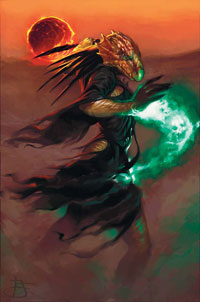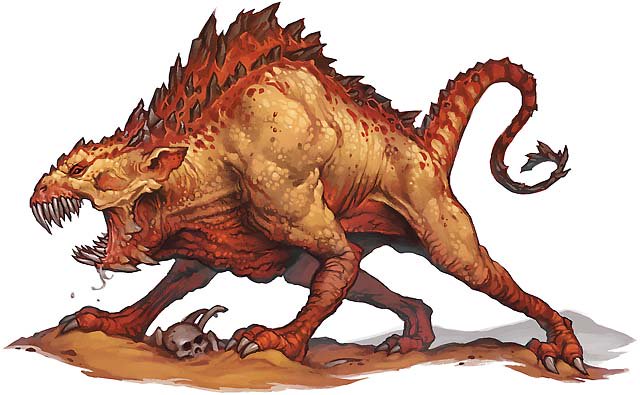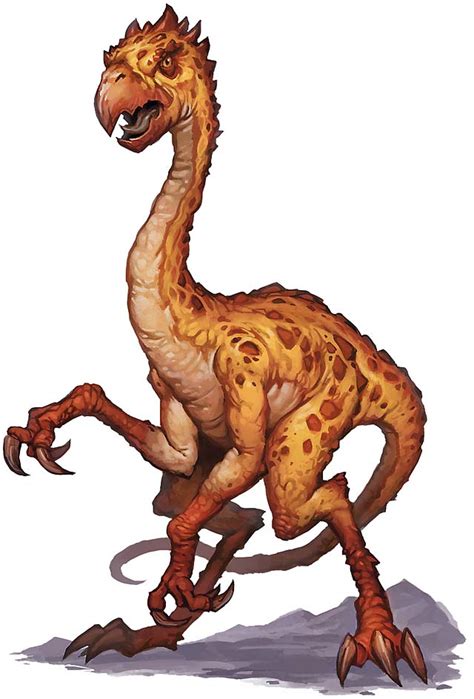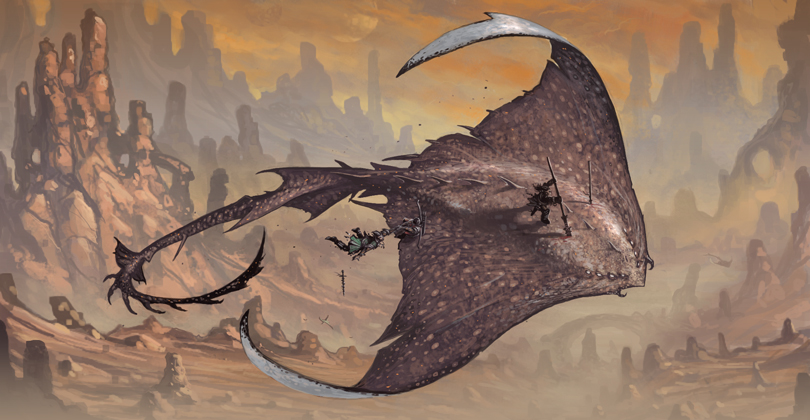Posts
-
Let's Read the Dark Sun Creature Catalog: Dragonborn (Dray)

A dragonborn sorcerer in the Athasian desert. Copyright 2010 Wizards of the Coast. This post is part of a series! Click here to see the rest.
Despite the title of their entry, these Dragonborn are not a new addition. Dark Sun is one of two 2e settings (that I know of) that had draconic humanoids in it since its initial publication.
The Lore
Despite using dragonborn stats for the PC version, these are not the same dragonborn as the ones from the standard Points of Light setting. Athasian dragonborn are known as Dray, are lankier than the standard variety, and have a completely different origin.
The Dray species was created by the sorcerer-king Dregoth to be his perfect servants and minions, but he was dissatisfied with the result and cast most of them out of his city-state of Giustenal. Those he allowed to stay kept serving him until the other sorcerer-kings banded together to destroy Dregoth and his city.
Today’s Dray are descended both from the outcasts and from the survivors of Giustenal’s destruction. Their total population is relatively small and few people know of their existence. Their communities are either small scattered tribes in the wastes or the rare enclave embedded in a larger settlement.
Their reputation among those who know about them is as slavers and sorcerers. Not All Dray (TM) deserve this reputation… but a significant majority of them do. They practice defiling magic and slavery, and frequently act as mercenaries for other groups who are okay with this. In this, they continue the cycle of abuse, inflicting on others what their creator inflicted on them.
The Numbers
Dray, like standard dragonborn, are Medium Natural Humanoids with a Speed of 6. They can use a Dragon Breath once per encounter, a Close Blast 3 vs. Reflex that deals some sort of elemental damage and whose details vary with the stat block.
You can easily use standard dragonborn stat blocks from the other monster books as more dray varieties if you need to.
Dragonborn Slaver
These assholes roam the desert looking for easily taken captives that they can sell to the sorcerer-kings in exchange for money and prestige. They’re frequently found in mixed-species slaver parties as their rank-and-file muscle.
Slavers are Level 16 Minion Soldiers that fight with Bastard Swords which damage and mark for a turn on a hit. Their Dragon Breath deals lightning damage and marks (save ends).
They’re tougher than your average minion too - the first time they drop to 0 HP, their Determined Defender trait lets them recover, clear any effects on them, and get back on at the start of their next turn. This makes them more willing to risk harm when surrounding the PCs.
Dragonborn Scorned Champion
A few dray take pride in being scorned by their creator, making that part of their identity. I’m guessing these are the nicer ones, since it would make sense for them to reject the ways of the sorcerer-kings. The Scorned Champion is an example of someone who might rise to lead a community of these Dray. Still, he’s sensitive to anything he perceives as a challenge to his position, and is quick to strike down the source of that challenge.
The Scorned Champion is a Level 16 Skirmisher with 151 HP. This cocky fighter’s Bravura Poise acts as an aura (1) that forces enemies inside to grant combat advantage. He fights with a scimitar that damages the target and lets him shift 1 square on a hit. The Dray Fury special attack (recharge 4+) lets him shift his speed and strike twice with the scimitar at any point during this movement. His DragonBreath can exclude one creature of his choice from the blast, and deals fire-and-lightning damage. Finally, his Unstoppable Force power lets him immediately end any Slow or Immobilize effect on him once per round.
Dragonborn Defiler
Drays like this one go in the other direction - they look fondly upon the past when they could walk the streets unchallenged, openly displaying their arcane might. They want the power to do that again, and see defiling as the quickest way to get there.
The Defiler is Level 18 Artillery with 129 HP. They use daggers as weapons and implements, and the damage roll on this attack has a funky format that mixes physical and cold damage. Their basic ranged attack is a Dragonfear Ray (ranged 10 vs. Will) that deals psychic damage and causes the target to take 5 damage each time they damage the defiler or one of its allies, until the end of the target’s next turn.
Their dragon breath has been corrupted into a Defiling Breath (close blast 5 vs. Reflex) that deals immediate and ongoing cold-and-necrotic damage (save ends). While at least one target is taking this ongoing damage, the defiler has +2 to all attacks and +5 to all damage rolls. This recharges if the defiler misses every target with the power, so it will keep doing it until it hits someone.
Once per encounter the defiler can cast Flight of Dragons as a move action, allowing every ally within 5 squares to fly 5 squares, and flying 10 squares itself. It doesn’t provoke opportunity attacks when it leaves its starting square, but obeys the rules normally from that point on.
As a minor action it can also use Hurled Dragon Breath (recharge 5+) to do just that with a less corrupt form of its breath. This is either a Close Blast 5 or an Area 2 Within 10, both targetting Reflex. It deals cold damage on a hit.
Dragonborn Atavist
Dray like this one prefer to focus on the bestial nature of their dragon heritage, using ritual techniques to tap into that inner beast and bring it forth during combat. Why use weapons when you have the power of a dragon at your disposal? This one’s a Level 19 Brute with 220 HP and Resist 10 Acid.
Their basic attacks are a strong Bite and a slightly less strong claw, both of which deal ongoing acid damage on a hit (save ends). Draconic Fury (recharge 5+) lets them use both attacks with one action, or even engage in a classic claw/claw/bite routine if they’re bloodied.
Their dragon breath, as you might expect, does acid damage.
Encounters and Final Impressions
It seems the only stat block here that’s actively Evil is the Defiler - everyone else is unaligned, even the slavers. I’m not sure I agree with that last part, but I suppose you can use the slaver stat block for a more conventional non-evil warrior.
I’m glad the game gives us some tools to stat up a non-evil group of Dray. PCs have to come from somewhere, and it’d get a little samey if all of them were nonconformist rebels fleeing their evil upbringing.
-
Let's Read The Dark Sun Creature Catalog: (Not) The Dragon of Tyr
At this point in our read-through of the Dark Sun Creature Catalog, it the next entry in the book would be the Dragon of Tyr. As I mentioned in the corresponding RPG.net thread, however, the Dragon’s touches upon the setting’s deepest secrets. These only appear at the very end of the Dark Sun Campaign Setting book, which forum user zedturtle is reading in another thread. I don’t want to spoil him ahead of time.
The other reason for this is that the Dragon of Tyr is a singular character and a very important one in the setting, so he should really be over on the Personages section of the book.
For both of these reasons, I’m discussing the Dragon at the end of this Let’s Read.
-
Let's Read the Dark Sun Creature Catalog: Dagorran

A dagorran, which is a cross between a lizard and a large dog with wicked sharp teeth. Copyright 2010 Wizards of the Coast. This post is part of a series! Click here to see the rest.
The Lore
Dagorrans are carnivorous reptilian quadrupeds the size of large dogs. They can track prey by its “psychic scent”, which they can memorize either through direct contact or by stumbling into a creature’s psychic trail (i.e. through psychometry). Once a dagorran has its chosen prey’s scent, they will chase it relentlessly, across great distances, until they catch it.
In the wild, these creatures live in wide-ranging packs. Dagorran packs sleep for a handful of hours every couple of days, and spend the rest of their time on the hunt. They only stay at a single place for a while when they have to rear their young, but as soon as the pups can run with the pack they’re on the move again. Unlike some of the other magical beasts in the book, dagorran packs don’t cooperate with other predators.
Young dagorrans are sometimes captured and trained by templars, who prize them as peerless trackers and use them to track fugitives or wanted dissidents. They’re much better at this job than cilopses, who must lay eyes on the prey to start tracking and can only follow the trail for a short time.
The Numbers
Dagorrans share some similarities with baazrags (dog-like pack hunters) and with cilopses (favored templar pets), but they’re a lot more dangerous with levels in the mid-Paragon tier. They’re Natural Magical Beasts so we can consider them sapient, though I guess their thought processes are pretty alien. The creatures can understand Common, and they can communicate telepathically with other dagorrans but not with anyone else.
They have a ground speed of 8, low-light vision, and the Psychic Scent signature trait. This is a minor-action power that lets them choose a living creature or its tracks within 10 squares of the dagorran. The dagorran can ignore any level of concealment or invisibility on its chosen target, and knows the creature’s location until it either dies or the dagorran uses the power again. No wonder templars like them.
Dagorran Mindhound
These robust specimens charge in packs to surround and distract their chosen prey, opening them up for attack by their sneakier relatives (below). They’re Level 16 Brutes with 194 HP.
Their only attack is a bite that does respectable brute-tier damage, but that and Psychic Scent are enough to make them a threat.
Dagorran Ambusher
These sneaky specimens move a bit ahead of the pack and position themselves for an ambush, striking once their beefier relatives (above) begin their own part of the attack. They’re Level 17 Lurkers with 132 HP.
Ambushers deal extra psychic damage against any creature that cannot see it. This trait is somewhat confusingly named Combat Advantage. I mean, if you cannot see the ambusher you will most likely be granting it CA, but if you can see it you won’t take bonus damage even if you’re granting it CA for other reasons.
That difference will soon cease to matter, however, because their bite makes them invisble to the target for a turn on a hit. If they’re too far away to bite, they can use their standard action to Fade to Nothingness and become invisible either until they attack, or until the end of their next turn.
It’s a classical lurker setup, but the rider on their bite attack means that they can keep biting you with bonus damage for as long as they keep hitting.
Encounters and Final Impressions
Dagorran encounters are simple. A wild pack is an all-dagorran encounter. You can also find one or two of them as part of a Paragon-tier templar encounter.
Dagorrans feel a lot more “dog-like” than baazrags lore-wise, but not mechanics-wise as they lack the ability to knock people prone or any Pack Tactics style power. I think they work better as pets brought in by mixed humanoid encounter groups, since those can be more varied than a wild pack. A chase scene or skill challenge involving dagorrans is a much more drawn-out affair than one involving cilopses, as the PCs will likely have to kill or discourage the dagorrans before they can attempt to lose their pursuers.
I did find a bit surprising that they’re mid-Paragon monsters, but their stat blocks are simple enough that you could reduce their level by 10 or so and still have them work just fine as Heroic threats.
-
Let's Read the Dark Sun Creature Catalog: Crodlu

A cilops, which is a giant centipede with one big angry eye on its head. Copyright 2010 Wizards of the Coast. This post is part of a series! Click here to see the rest.
Crodlus are what Athas has instead of horses. Fans of Final Fantasy might compare them do Darker and Sunnier chocobos.
The Lore
In the wild, crodlus roam the wastes in small herds of about a dozen members, led by a dominant female. Females make up most of the other members of the herd, and are all related to the leader. One of the males will be the leader’s mate, with the others being mostly younger individuals who have not yet reached adulthood. When that happens, the newly adult males set out to seek mates in other herds.
The creatures are omnivores, with herds cooperating to hunt those creatures they judge to be weaker or smaller than themselves, and running away from stronger predators. They’re also frequently beset by human raiders trying to capture their young for training as mounts.
This means that crodlu are a common sight among groups of sapient humanoids. They make for ornery mounts, but that’s a good trait to have in something you want to ride into battle.
The Numbers
Crodlus are Large Natural Beasts with the Reptile tag and a ground speed of 8.
Crodlu
This could represent a typical wild specimen, or perhaps a domesticated one that wasn’t trained as a mount. It’s a Level 3 Brute with 55 HP.
The crodlu can attack with its beak or with claws that do a little less damage. Whenever it can it will use a Pounce, which lets it move up to its speed, and use both Beak and Claws against the same target even if it stands still. If both attacks hit, the target falls prone.
War Crodlu
This one was trained as a mount, and compares to the normal crodlu in the same way a war horse compares to a draft animal. It’s a Level 5 Brute with 76 HP.
The War Crodlu has the same three abilities described for the normal version, and one more: Pouncing Mount. If the war crodlu charges a target while mounted, its rider can make a melee basic attack as a free action against that same target. The Pounce ability does not count as a charge, but this makes the charge of a mounted war crodlu a bit more dangerous than a standard Pounce, depending on who the rider is.
Encounters and Final Impressions
Crodlus don’t strike me as the type of animal who’d attack wandering PCs without provocation, so they’ll mostly likely be found serving as mounts for bad guys or for the PCs themselves. Fighting wild ones would be something that happens when the PCs decide to play hunter and steal hatchlings to sell or domesticate.
Mechanically they’re very simple, about on par with horses really. I’ve been too desensitized by FF chocobos to see terror bird mounts as a mind-blowing innovation, but they’re still kinda cool.
-
Let's Read the Dark Sun Creature Catalog: Cloud Ray

A cilops, which is a giant centipede with one big angry eye on its head. Copyright 2010 Wizards of the Coast. This post is part of a series! Click here to see the rest.
The Lore
Cloud rays look like gigantic flying stingrays, and are among some of the rarest and most majestic specimens of Athasian fauna. They float in from the Sea of Silt to feed or rest, and despite their prodigious size they’re rarely dangerous unless bothered.
These creatures subsist mostly on psychic, entropic, and magical energy, so they only need a comparatively tiny amount of physical food to keep going. They land on the ground to sleep, covering themselves in sand and debris for camouflage. There are many stories about travelers who pitched their tents on a nice spot of high ground only to later find themselves desperately clinging to the back of a cloud ray when the creature took flight.
Cloud rays dream of distant places when they sleep, and sometimes they disappear to those places instead of taking flight the usual way. When threatened, the creature can consciously tap into this ability to teleport short distances.
The Numbers
Cloud Rays are Elemental Beasts, whose size varies depending on their age. They can crawl on the ground at speed 4 and fly at Speed 12 with Hover capability. They have an affinity for storms, with Resist 15 Lightning and Thunder.
We’re going through the entries here in increasing order of level, which is the reverse of what the book does.
Cloud Ray Pup
This young individual is Large, translucent, and relatively delicate for its size. It’s a Level 21 Minion Skirmisher. Pups fly around in clusters near other creatures that can provide them with food - most commonly cloud ray elders, but sometimes other aerial predators that tend to leave lots of left-overs. If their intended prey is still moving, they sting it until it stops, and then set down to eat.
Their sting is Reach 3 and deals thunder damage. They can employ it as part of a Gliding Attack that lets them move their speed and make the attack at any point along the way. They don’t provoke opportunity attacks when moving away from the target of their sting.
As a minion, a single hit will take the pup down, but it can use Dream Resurgence once per encounter to remove itself from play when it reaches 0 HP and reappear at the start of its next turn within 10 squares, with its 1 HP restored. It will probably use this opportunity to run away if nothing is forcing it to stay, so the PCs don’t need to feel bad about giving this beautiful creature a good whack to get it to bother someone else.
Cloud Ray Adult
Adults cruise the skies continuously, only descending to rest or to attack land-bound prey. Sure, it eats little for its size, but for a Huge creature that can still mean its infrequent meals consist of a whole person or similarly sized animal. Adults are Level 23 Elite Skirmishers with 424 HP.
The adult has a much stronger version of the pup’s Sting, with Reach 4. It can also use a Reach 1 bite that deals more damage and grabs the target. Targets grabbed by the bite have a -4 to their escape rolls, which have escape DCs of 34 for Athletics and 36 for Acrobatics. The ray can grab at most one target like this. The Unhindered trait lets the cloud ray pull the victim along when it moves. Either of these attacks can be used as part of Gliding Attack, which lets it attack twice during the movement and otherwise works like the pup’s version.
A ray that finds itself surrounded can use Wing Storm (Close Burst 3 vs. Fort, recharge 5+) to deal thunder damage and push targets 3 squares on a hit, also knocking them prone. This creates a lightly obscured zone that lasts for a turn, from all the dust it kicks up.
Once per encounter, while bloodied, the ray can use Dream Flight to teleport 15 squares, carrying its grabbed victim with it if it has one. It makes Close Burst 2 attack vs. Fortitude on arrival, dazing an slowing those it hits.
A grabbed victim can be attacked with further bite attacks and with Crush, a minor action attack vs. Fortitude that deals as much damage as the bite.
An adult on the hunt will try to grab its chosen prey and fly away, biting and crushing the victim until it’s dead. If their prey proves too feisty, they’ll drop it from a great height to soften it up, and then grab it again. Repeat until done.
Cloud Ray Elder
This majestic Gargantuan beast is a Level 25 Solo Controller, on par with elder dragons from other worlds. Its control over storms lets it project an aura (3) of Undulating Winds, which deals 15 thunder damage to enemies that start their turns inside and lets the elder slide them 3 squares to another square within the aura.
Also, its Flat Body lets other creatures enter and occupy the elder’s space - they’re standing on top of the ray! This means it’s equal parts enemy and terrain during a fight. If it took flight because you tried to camp on its back, it will be the only terrain for the fight.
Obviously if you’re on top of the ray, you’re also inside its aura, so it will try to slide you off its back. This follows the rules for forced movement into hazardous terrain, so you get a save to grab on before you tumble to the ground. If you pass, you end up prone at the ray’s edge.
The elder’s is Reach 5 Sting deals immediate and ongoing thunder damage (save ends). Its favorite attack enhances the sting with magic for a Thunder Lash, which deals physical damage to its primary target and triggers a secondary close burst 5 centered on that target that deals thunder damage to all enemies it hits and pushes then 3 squares. On a miss it deals half damage.
It’s also large enough that its bite upgrades to Scooping Bite: this is a Close Blast 5 instead of a melee attack, and it can grab up to three targets it hits. Unhindered is here and lets the elder fly away with its mouthful of victims. Gliding Menace works like Gliding Attack, but lets the elder specifically use Thunder Lash and Scooping Bite as its two flyby attacks.
Like the adult, the elder can Crush its grabbed victims with a minor action. Fortunately they don’t have penalties on their escape rolls, but the base DCs are higher since the elder is higher level.
If bloodied, the elder uses Dream Flight to teleport away. It works just like the adult’s version, but the daze upgrades to Stunned on the first failed save and Unconscious on the second.
Encounters and Final Impressions
Cloud Rays are almost always only found together with other cloud rays, with a flock of pups following a group of adults or a single elder around. They’re not sapient but I think they’re smart enough not to attack heavily armed PCs without provocation. Encounters are more likely to start when a PC runs into a ray at rest, and even then a fight is not certain.
I imagine you can have a good adventure about PCs trying to prevent another armed group from killing cloud rays, and in this case the creatures would not be smart enough to distinguish the PCs from the hunters if a fight broke out.
subscribe via RSS